Ok, this post is going to be a bit different—it’s all game design chat, so if you want my usual content, you may want to skip this one, and don’t worry, I’m not turning into one of these nutters doing 7-hour long lore videos on YouTube.
I’ve always been interested in interactive design, and it’s something I often think about, often just as a puzzle. I have written about games here and there in this newsletter, but today I want to talk mostly about Elden Ring. The game is an almost-masterpiece, and its flaws have been bugging me for some time, as I can’t help but think how these issues could be resolved. Many of my gripes probably aren’t problems to a lot of people, and that’s fine—again, I’m approaching it as a design exercise, rather than as a critique.
THE MAP AND THE TERRITORY
One of the best decisions in Dark Souls design was not having a map, and not having fast travel until the middle of the game. It added something to the game, which had been lost for a long time—a sense of building the geography and learning the environment on foot. When you walk around, you get the sense of the place that you can’t get in any other fashion. If you take a car everywhere, or even bike, your body isn’t keeping up and your brain isn’t feeling the scale. After all, we’re still the same animal that got around by foot back in the simpler times, and our bodies have not evolved in any way to account for airplanes, let alone teleportation.
Elden Ring made a significant concession, by having a fairly detailed map (hidden by fragments, which are very easy to unlock), and allowing fast travel from the beginning. The map makes sense in a world as large as Elden Ring’s, but the immediate fast travel, I think, was a mistake.
Here’s how it could’ve retained that sense of mental geography, without turning into a slog:
allow teleporting only through the Sites of Grace
require a limited, but easily obtainable resource for each teleportation—something similar to Humanity in Dark Souls
have fewer Sites of Grace, and replace some of the redundant ones with checkpoints (stakes of Marika), so that if you die, you never have to go through a long trek
to balance out this limitation, simplify weapon upgrades and make them accessible at any Site of Grace—since you can do leveling/Ashes of War this way already, having to teleport to the smith every time feels like a half-measure. Instead, there can be smiths in the world, similarly to Dark Souls, but they’d be unlocking certain upgrades or whetblades, and otherwise adding rare and more significant elements to the progression
have more shortcuts in the open world—these do exist, but are mostly useless, since you might as well just teleport around
These changes would give the game a much greater sense of adventure. You wouldn’t just jump around doing bits and bobs, you’d have to plan ahead for a journey to this or that part of the map, consider what spells you’re bringing, how many flasks you have allocated, etc. You’d also know that you need to think about getting back to safety. It would also discourage premature exploration—you’d know that if you run too far, you’ll also have to figure out your way back, or be prepared to use up a limited resource.
LESS EVERYTHING
There’s a survival element to previous From games that’s mostly lost here. There are too many resources, far too many weapons, not to mention crafting, which I must’ve used 4 or 5 times in total. For me (and many others, I gather), the best part of Elden Ring is the beginning, when you’re figuring things out, and everything feels new and exciting. It’s unrealistic to expect this novelty to sustain itself, but it can be stretched at least a bit, by limiting the options and resources, as well as limiting exploration, or making it less effortless than running to the farthest corners of the map, gathering all that is on offer, and teleporting back.
Corpse-running is in fact one of the things that should’ve been abolished, and here it’s worse than ever. Of course you can say that it’s an option to make the game easier, and you don’t have to do it, but there are better ways to make the game more accessible, while keeping it restrained (more on that further).
I’d make the player vulnerable and easily interruptible when they open doors and chests, so you have to think how to get around enemies in order to gather the loot. It doesn’t mean that you have to fight them—this approach would encourage the use of many elements that are overlooked by most players (myself included), like stealth, lure, or sleep arrows. Most of the time, it simply isn’t worth the bother.
AMAZING CHEST AHEAD
Early in the game there is a chest that teleports you to a scary dungeon in Caelid—it’s one of the most enjoyable twists in the early sections, since it catches many players off-guard, and forces them to engage with a much harder part of the game, by using stealth or evasion. I didn’t realize you can just walk out to the right and teleport, and spent a great deal of time sneaking through the path on the left, until I got to the boss and died immediately. That sneaking part was unexpected and rewarding, even if it was a blunder in the end, and made me wonder why there isn’t more of that. Putting players in occasional situation, where they have to figure out a solution, and can’t just leave, is a great way of combatting open world fatigue, where everything is a bit too accessible, and the only challenge is that of patience.
SAD CHARACTERS, BIG WORLD
I think it’s safe to say, the game is too big. You could add a few years to development, add more variety, instead of recycling enemies and bosses, tighten up the late-game areas, and it would definitely improve the overall thing, but you could just trim some 25% (or even more) and not lose much.
Another staple of From Soft’s philosophy is allowing players to miss out on things, often the best parts of the game, like the Painted World in Dark Souls or Castle Cainhurst in Bloodborne—both aren’t too hard to find, but do require some work. Elden Ring still has that in the beautiful but exhausting Haligtree, but for the average player, the chance of not seeing at least one instance of every boss and enemy is fairly low.
I remember stumbling upon the singing harpies in the first 10 hours, and it felt like an exciting discovery, almost like witnessing something you shouldn’t have seen. There’s no gameplay element to it, just a bit of world-building. Then you see them again, and again. It’s fine—why shouldn’t there be more than one singing harpy, but every time I’d see them, it felt like it diminished the memory of the initial encounter.
I think there should be a mixture—some things bear repeating (ideally, with some variations), but more things should feel unique, which adds a huge incentive to exploration and makes you appreciate the discoveries, knowing that behind each corner, there might be something you won’t see anywhere else. The encounters with Boc and Patches in random caves are good examples of this at work—perhaps there could’ve been hints, guiding you to their locations, but the unexpected encounters made these caves so much more interesting, and gave me the (largely unfulfilled) expectation that any other cave might have something like that.
It happens sometimes: when Patches moves to Liurnia, he lights a bonfire, which is relatively easy to spot. Most of the time, they just appear somewhere, and in a game as gigantic as Elden Ring, it’s a bit unreasonable. One solution would be to only have them around Sites of Grace, which can help if we reduce their number dramatically, as I suggested above. That would feel pretty video-gamey though, perhaps it can apply to the most important ones only, the way it’s been done in the DLC.
A better solution would be to have a higher amount of subtle sign-posting. So, when an NPC moves somewhere, you can have 4-5 pieces of small evidence. No yellow tape, just little hints that add to the story, and don’t just serve to guide you. For instance, it can be a few visual alterations to the nearby area, then a few changed lines in other NPCs’s dialogues, item descriptions of course, and maybe even enemy behavior. For instance, upon returning to a Site of Grace, the pack of wolves that roams around there starts howling and runs off into the forest. If you follow them a bit, you will hear them getting killed by the NPC. It’s very scripted, but if you have lots of such small events, they can add up to something that might organic.
Then there’s the issue of the size of the game—by the time you meet some NPC again, you’ve probably forgotten everything about them from your first meeting some 20 hours ago. Traditional solution is to have quest logs in the menu, and I think From could’ve included that, with their own spin, the way they have integrated a map without all the videogamey clutter (unless you choose add the clutter by hand). The logs can be as simple as objects in your inventory that update as you go through the story, so you’d examine something like ‘memory of Boc’ and get a little description of your first encounter.
Additionally, the NPCs could stand to give a bit of a reminder without losing the incomprehensible narrative style that From popularized. And of course, it would be great to have more frequent NPC encounters, even if they are very minor. A good example is Gostoc who follows you through your time in Stormveil Castle, which made his character feel so much more alive than many others. Lastly, perhaps there can be some kind of messaging system—a carrier pigeon might drop by and give you a note from a character informing you that they are headed this way or that and would love to catch up. The most interesting stuff can happen if you have separate questlines intersect in unpredictable ways. Bloodborne explored this a bit in the interactions between the NPCs in the cathedral, though I’d never been able to follow the events without a guide.
LEVELING AND PROGRESSION
The biggest problem with the ridiculous amount of weapons available is that outside the first few hours, you can’t really test a new toy without upgrading it, and upgrading is a pretty tedious process, even when you have enough resources to hoard the smithing stones. I’d get rid of the weapon leveling system altogether—personally, I can’t understand what exactly it brings. The Scadutree fragment system, or what we had in Sekiro seems like a much more reasonable idea—your overall power rises through the game as you collect these fragments, and it applies to all equipment alike.
The leveling system feels particularly redundant with the Ashes of War and the many affinities that can be given to weapons in order to change their performance. With all that, the levels feel mostly like an inconvenience. I’m not fond of the overall leveling system either—it gives room for grinding if the player needs help, but once again, I feel like this can be achieved in more creative ways, by giving more options to tackle the areas and bosses.
THE IDEAL ACTION-RPG SYSTEM
My ideal system would be pretty straightforward—let’s say there are 50 progression items scattered through the games, in hidden chests, guarded by bosses, etc. Each one rises your level by 1, allowing you to increase your stats by up to 3 at first, then 2, and 1 at the end (this way the late-game items won’t be as valuable, so the player won’t be frustrated by missing one or two). You can respec with the Larval Tears, as you can in the game. Here’s a 3-part progression route, from basic learning to mastering, and finally testing the skills you’ve honed up to this point:
This system would make the business of balancing out a huge game like Elden Ring significantly easier, fix all online matchmaking problems, and would ensue a more consistent experience for all players, giving more challenge to those who want to blast through, and rewarding exploration for those who want to seek out all the items.
DIFFICULTY CURVE
Each recent From Soft game has had a similar approach to teaching the mechanics, mostly by torturing you. The first step is an almost inevitable death—a great opening, and not just because you should get used to dying a lot. Death (and rebirth) is woven and reinterpreted in each title, it’s central to all of the games, the atmosphere and the environment. You enter them by dying, and then learn to live with a constant threat of death at every corner.
What follows next is a usually a tutorial area that leads to a more-or-less manageable boss. Dark Souls 1 has the best tutorial I’ve seen, maybe ever—it teaches you everything you need to know, without holding your hand too much. Dark Souls 3 has a questionable twist—the first boss is (for me, at least) the hardest in the game, excluding DLC, and you can’t get around it by leveling up or finding better equipment—you simply have to git gud. Bloodborne has the same approach, with a much bigger opening area, which makes it a bit less frustrating. Elden Ring has the softest opening, giving you as much freedom to ease yourself in as you want—the first roadblock can be hours and hours away.
Practically all the previous games had a consistently flawed difficulty curve—it’s too hard at first, then flattens and even dips if you find a broken build, then rises to the top towards the end with ridiculously over-powered bosses. Elden Ring follows this curve path, more-or-less, but gives you more tools to deal with these inconsistencies. That is basically the game’s in-built difficulty slider. You can pretty much get through the whole game without even coming up to the bosses, just blast them from a distance and get on with it. Myself, I’m much more interested in exploration than learning movesets and tweaking builds, so I spent most of the game with some variations on a spellblade set-up, alternating between the Wing of Astel and Moonlight Greatsword, and occasionally going back to Moonveil when I just want someone to die as soon as possible, and then of course M’lady.
This, and the size of the game makes it probably the least balanced From title. It would be hard to fix, and arguably it can stay broken, thus allowing for greater variation for those who want more/less challenge. Again, the scale is part of the problem—Elden Ring is simply too big. The optional stuff should be there to help you, but not to over-level you to the extent that the game’s difficulty suddenly dips all the way down, right until we get to the final section.
Then there’s a huge discrepancy between the difficulty of exploration and the difficulty of bosses. I can’t even be bothered to take on the DLC bosses on my own, partly because I far prefer exploration, partly because the cranked up difficulty is a bit much. If you go out of your way to optimize the build and over-level, the following areas will be too breezy, too. I do remember the thrill of beating Genichiro and Lady Maria on my own, but at this point in my life, it’s just not worth the stress, so I’m very grateful for all the summoning options available.
Sekiro, for instance, was my most painful experience with From Soft games, as you can do very little to mitigate the boss difficulty. What’s even worse, it relies on reflexes more than any of the other games, and every time I’d see the perilous attack sign, I’d freeze in indecision and get slammed. The rest of the game was mostly excellent, but these roadblocks drove me to the brink a few times, especially when you have one NPC who assists you with the drunken fight—I don’t know why they couldn’t bring a few more along, since they’ve already established the mechanic.
DEAD SOULS
As a small aside, I really like that challenging bosses in the evergaols lets you keep your runes if you die. I’d apply that to all bosses—it’s never particularly hard to grab your runes, for the most part it’s just annoying, and the system is far more engaging in exploration, rather than in main boss encounters. It was different in previous games, where most bosses had significant walk-ups (eternal gratitude to whoever escorted me all the way from Firelink to the Four Kings—I was ready to give up at this point), but in Elden Ring it doesn’t really make sense. This would only apply to main story bosses behind fog doors, not the field encounters or named enemies.
TORRENT UNREPRESENTED
One of the thing From Soft does so well is tying every element that most games take for granted as part of the world design and story. Death and reincarnation, souls, even multiplayer, they all have some place in the lore, and when something doesn’t, it feels off. For one, there’s very little story around Torrent, your spectral steed. There are some hints and connections here and there, but it feels a bit wrong to use the poor creature so much and give it so little in return, especially after Sekiro did such a beautiful job giving a basic combat tutorial NPC a story arc with a rather moving ending.
In general, the cut content is pretty baffling here—finally, the merchants got a full story, and most of it was cut. Quite a lot in Elden Ring is recycled from previous games, and this is one of the truly new ideas, and I’ve often felt annoyed that almost no-one explored the character of in-game merchants in greater detail. Normally, I try not to engage too much with cut content, so as not to see how sausages are made, but these cuts are too good to be left out. I’m also baffled by the last-minute decision to kill one of the best lines in all video game history:
ENEMY INTELLIGENCE
On one hand, part of the fun of Dark Souls was learning the enemy placement and behavior, so you can then get from one bonfire to another. The game’s world is set almost like a play—everything happens as rehearsed, but you can interfere with it however you like. If the game randomized ambushes, it would keep you on your toes, but it would also add an element of unfairness. My solution would be to have several tiers of randomization, and have a randomizer distributing these randomizations. So, in one player’s world, a certain ambush will always remain the same, while in another one’s, it will be inconsistent. With time, these variables can slowly adjust, so you have a mix of learning patterns, and staying alert for variations.
Needless to say, all these variations add a lot of powder to the balancing keg, and once again, my solution for this is to keep all the variations as subtle and light as possible, so even in the unlikely event that all the worst eventualities stack up against you, it’s never more than a 10% adjustment in overall difficulty. The variations should be subtle enough to keep you alert, but not frustrated. For instance, an ambush might have two fellows with spears at one point, or a swordsman and an archer at another—it wouldn’t exactly ruin the world’s design, but it would add a little bit of unpredictability.
ENEMIES THAT AREN’T ENEMIES
One of the most disturbing parts of Bloodborne for me was the bit with the mechanical fellows towards the end—can’t remember what the location was, but I loved them because they don’t really attack you, and don’t pose much of a threat—they just stumble around sadly, and killing them doesn’t feel particularly good. It adds to the sickly atmosphere and makes the whole experience feel less like your typical video game, where everyone is an obstacle. Same for the wailing sad corpses at the bottom of Firelink shrine, and all the ghosts in the Shadow of the Erdtree. All of this adds to the atmosphere, and nails the feeling that this world isn’t for your benefit, you just happen to be in it.
BIG EMPTY FIELD
Elden Ring is possibly the only open world game that actually feels open. The only other successful example I can think of is Breath of the Wild, which was somewhat inspired by Dark Souls, and did in turn inspire the world design of Elden Ring. What they have in common is the treatment of emptiness. Some of my most memorable moments in these games were spent in areas that didn’t lead to any rewards or reveals—the parts that really captured the pleasure of getting lost.
Breath of the Wild loses some of its magic soon enough, when you realize how formulaic the height placement is—everything is stacked to keep you moving. Elden Ring is a bit subtler in this regard, and for the most part, the emptiness feels enjoyable to navigate. After Leyndell, things get a bit rushed and less considered—the emptiness starts to feel empty in a bad way, but it’s still better than what Nintendo did in Tears of the Kingdom.
MORE LIKE REAR OF THE CRAP DUNG
Here’s a controversial take—TotK ruined everything that made BotW special. The once-delicate world is littered with bland puzzles and fetch quests, wheels, planks and gimmicks. The whole construction system feels made specifically for TikTok content sludge, since for all its ostensible variety, there’s 1-2 things that obviously work best in any given situation, the rest is busywork. The dungeons they promised are even worse than the ones in BotW—at least those were original in their structure and presentation. And don’t get me started on the underworld…
It can be argued that Nintendo tried to narrow down the gameplay loops and focus on the most immediate ones—the pleasure of interaction. You have that in almost all their games, there is an almost tactile quality to all the jumps in Mario, or plucking in Pikmin. In TotK they clearly went out of their way to make the building mechanic simple and enjoyable in its process, but I still found it mostly irritating. It wouldn’t bother me in a game entirely about building things, but in the world of Zelda it just feels out of place.
IN CONCLUSION
I think a lot of obvious decisions in game design should be interrogated. From Soft did a lot of that in Demon’s Souls and Dark Souls, but from there on began to refine on the formula. Elden Ring is the conclusion to this search, and I hope that whatever they do next will be a departure. I’d be very happy with a smaller, denser game—something with fewer areas and fewer tools, but greater complexity to everything that’s placed in the world.
If you got all the way to the end, congratulations, ‘tis well met.




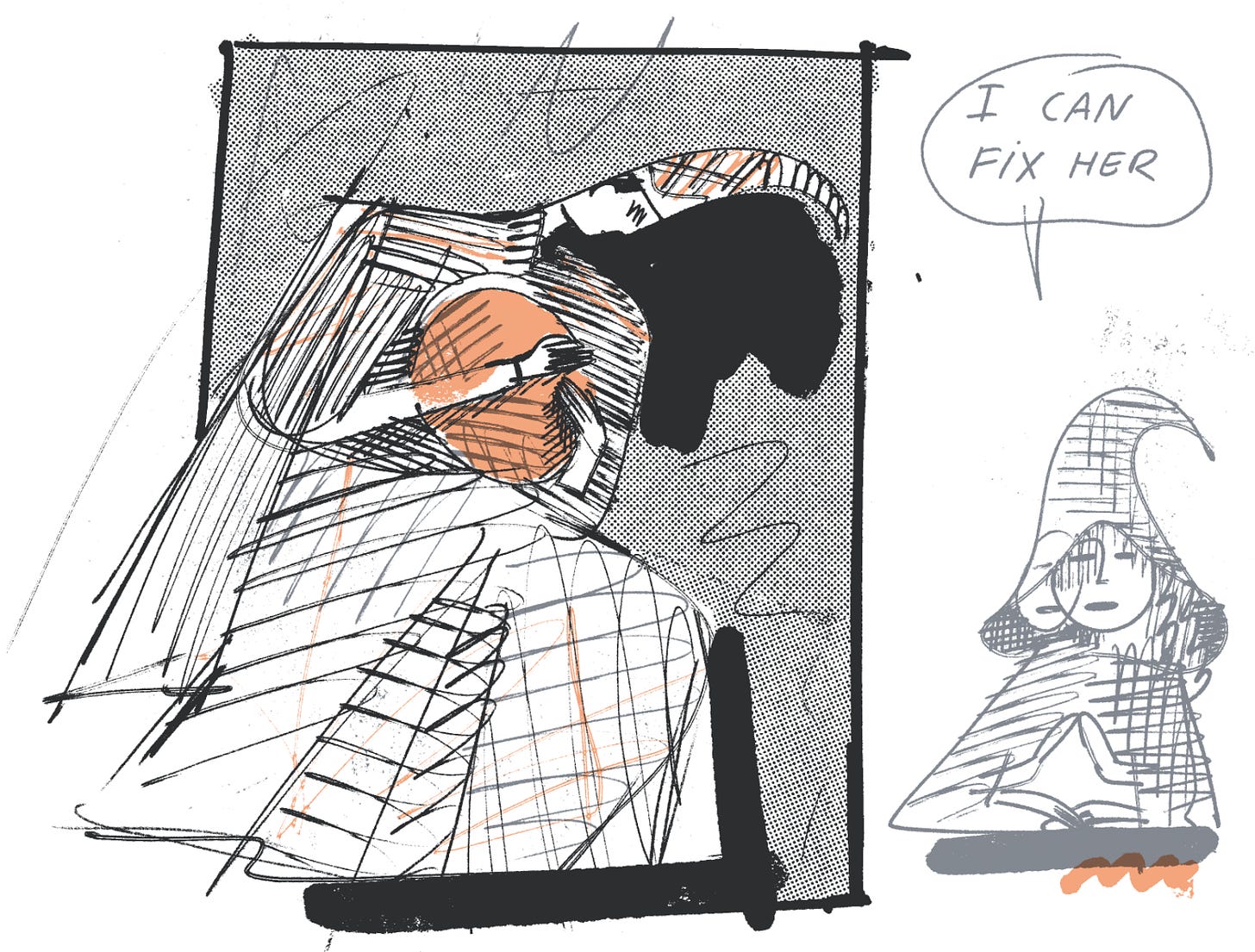

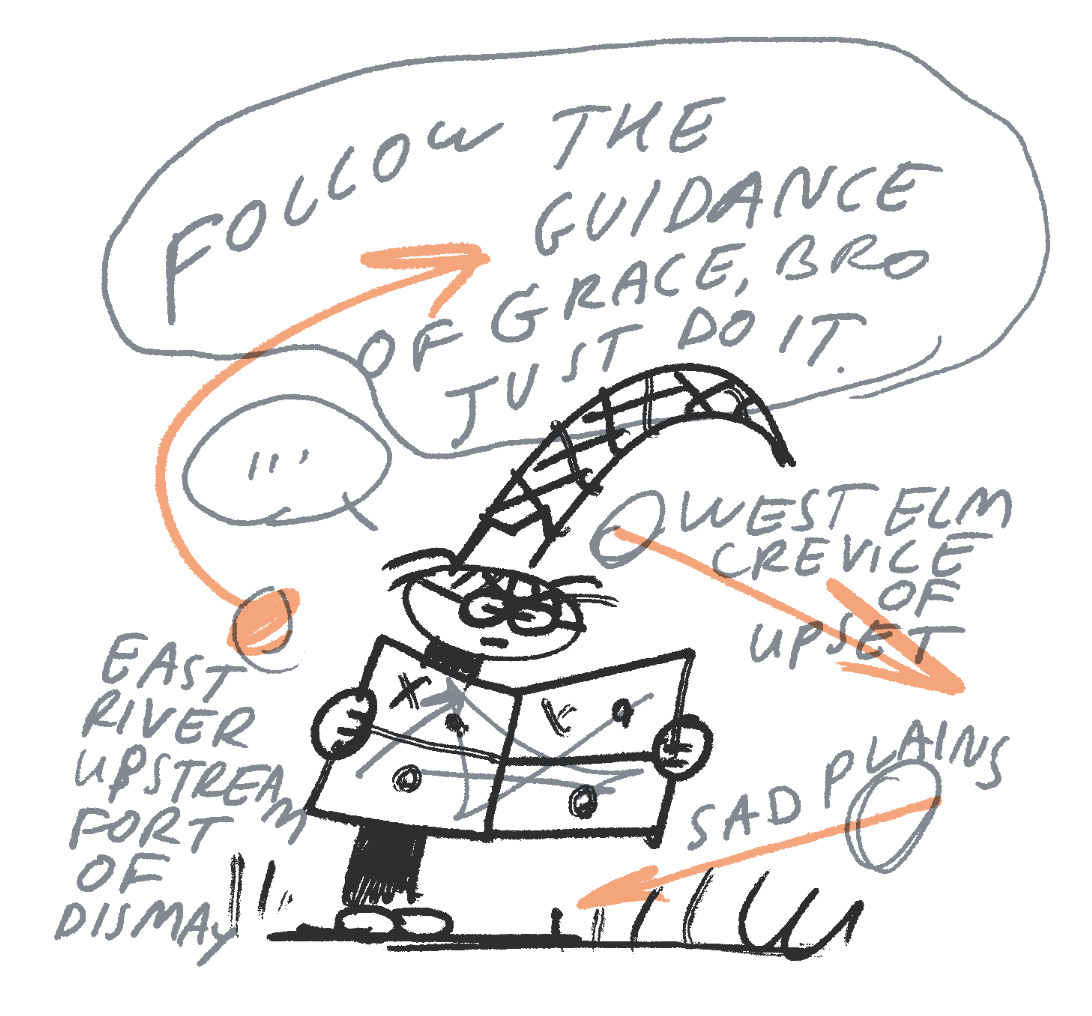
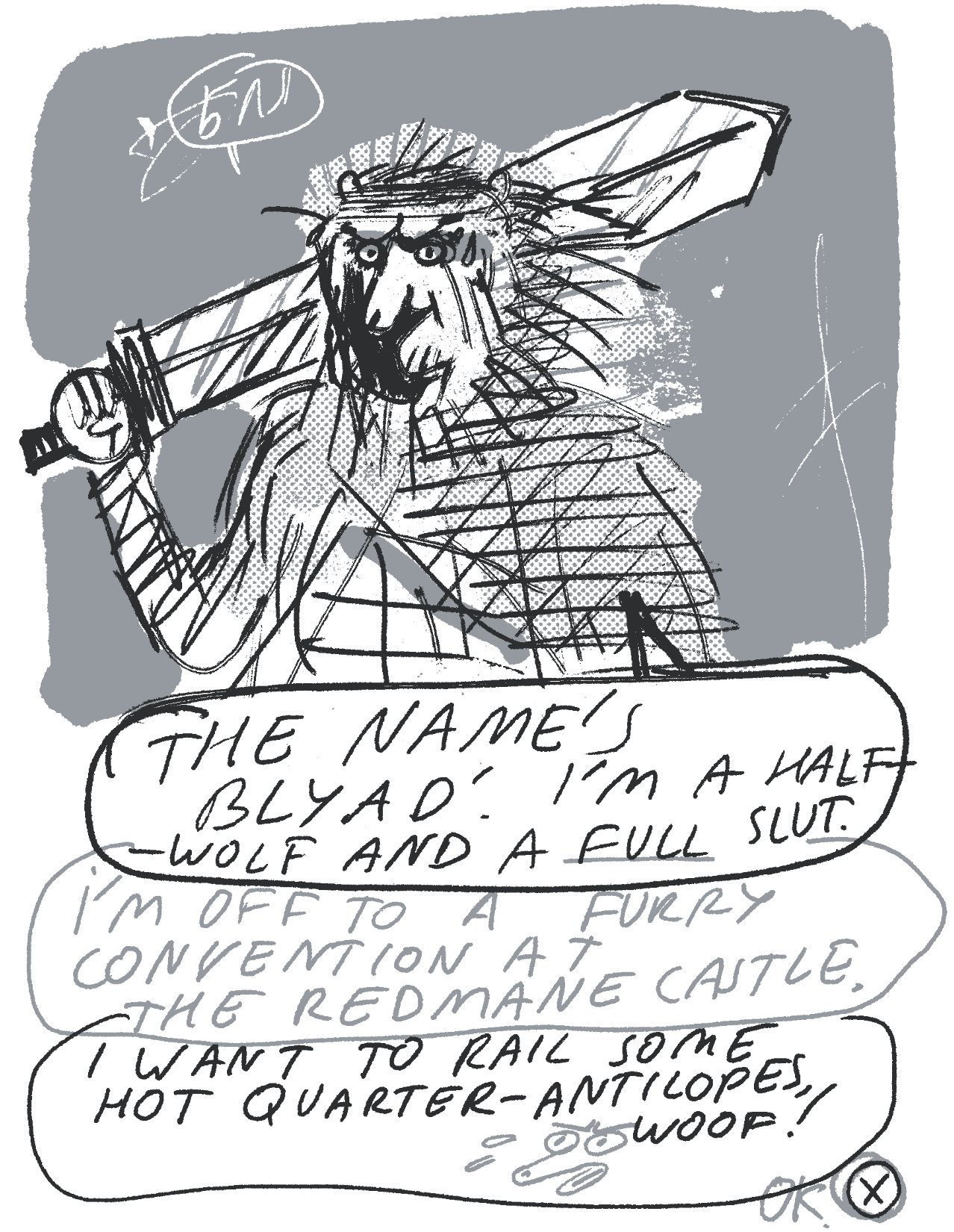

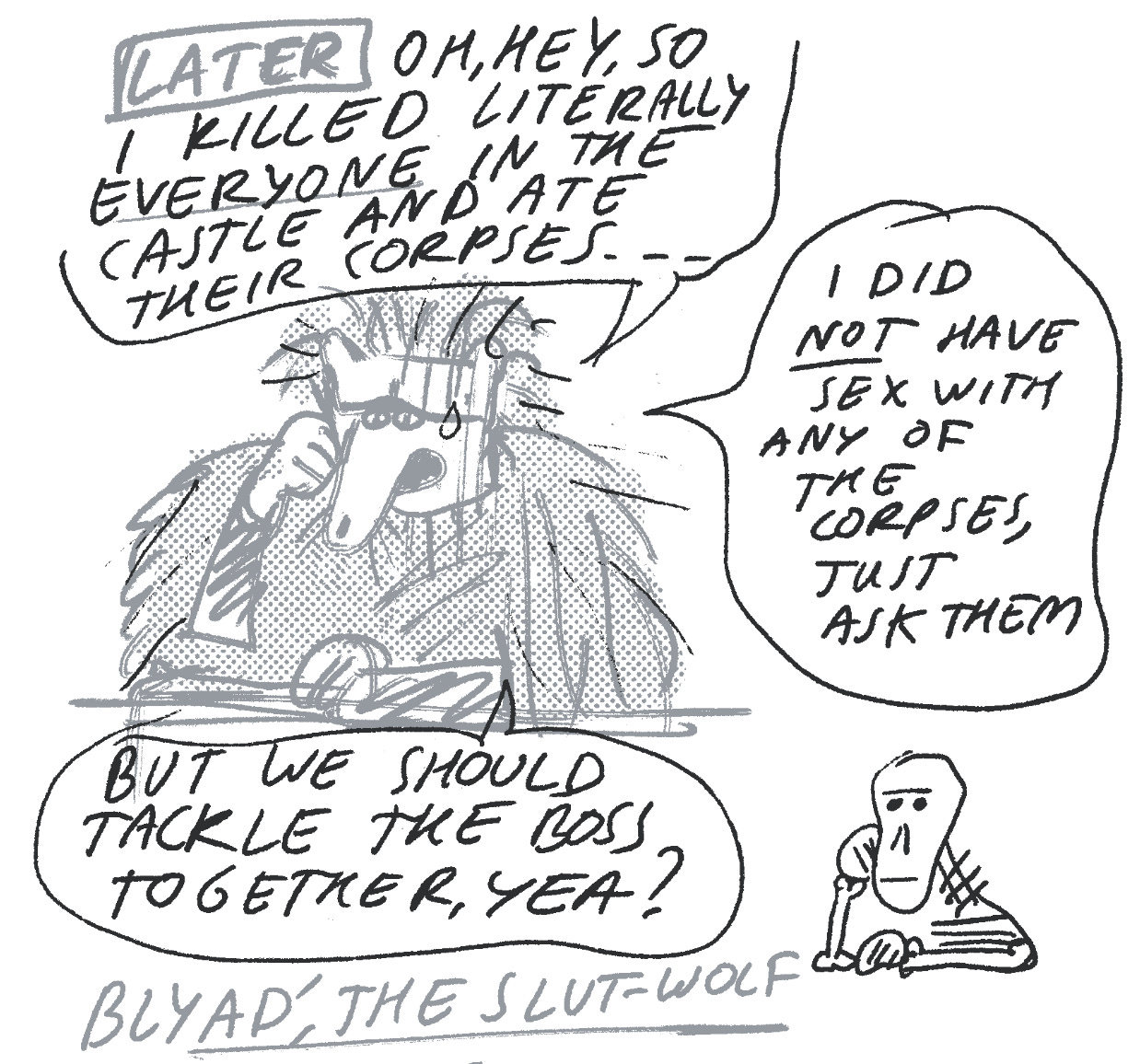
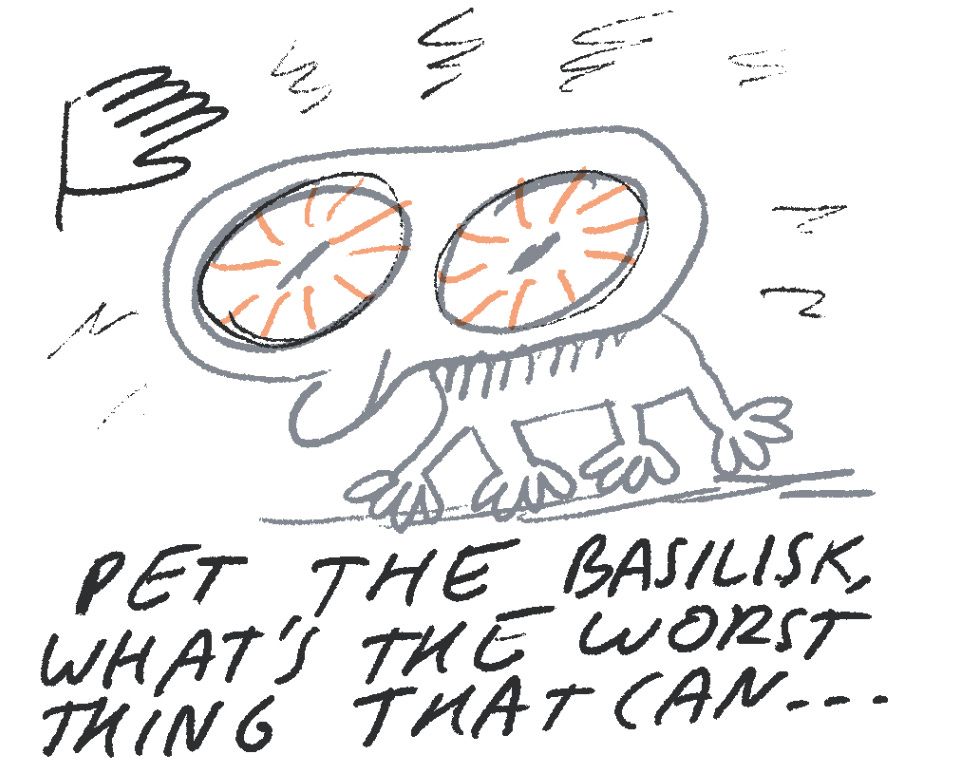
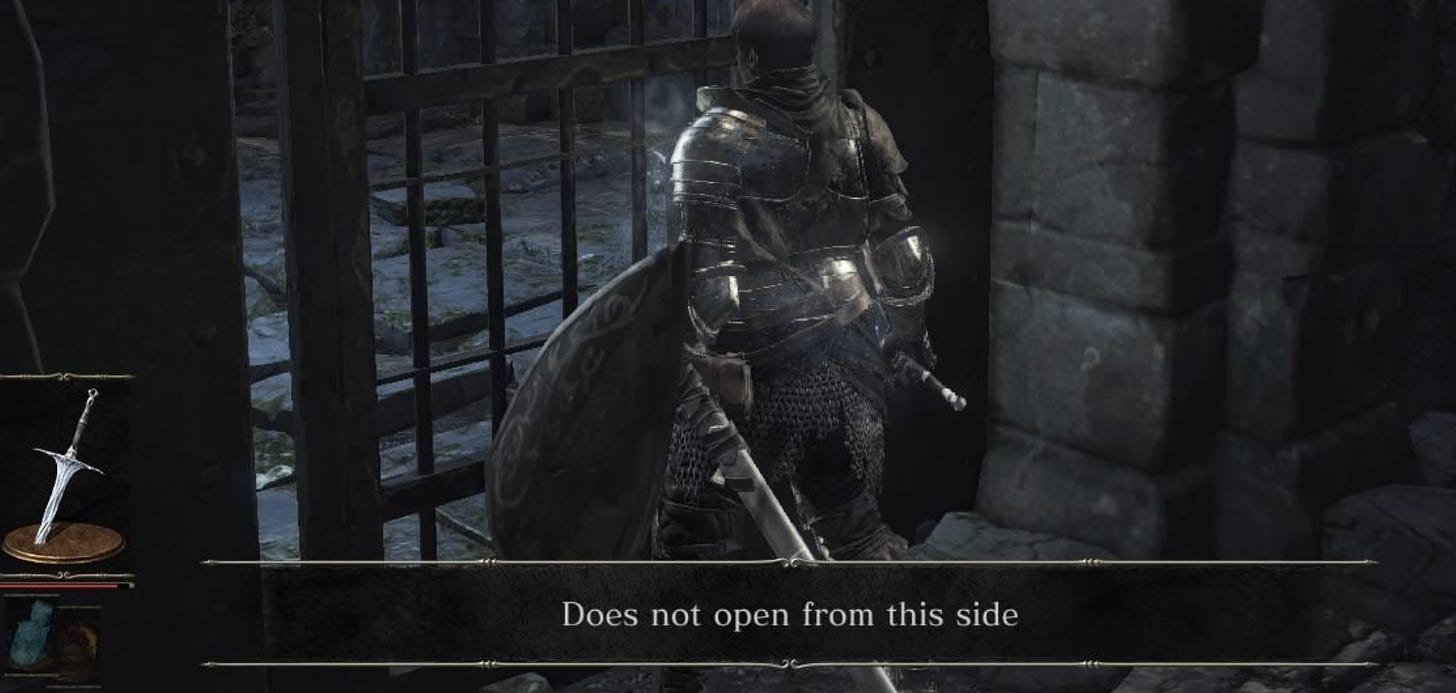


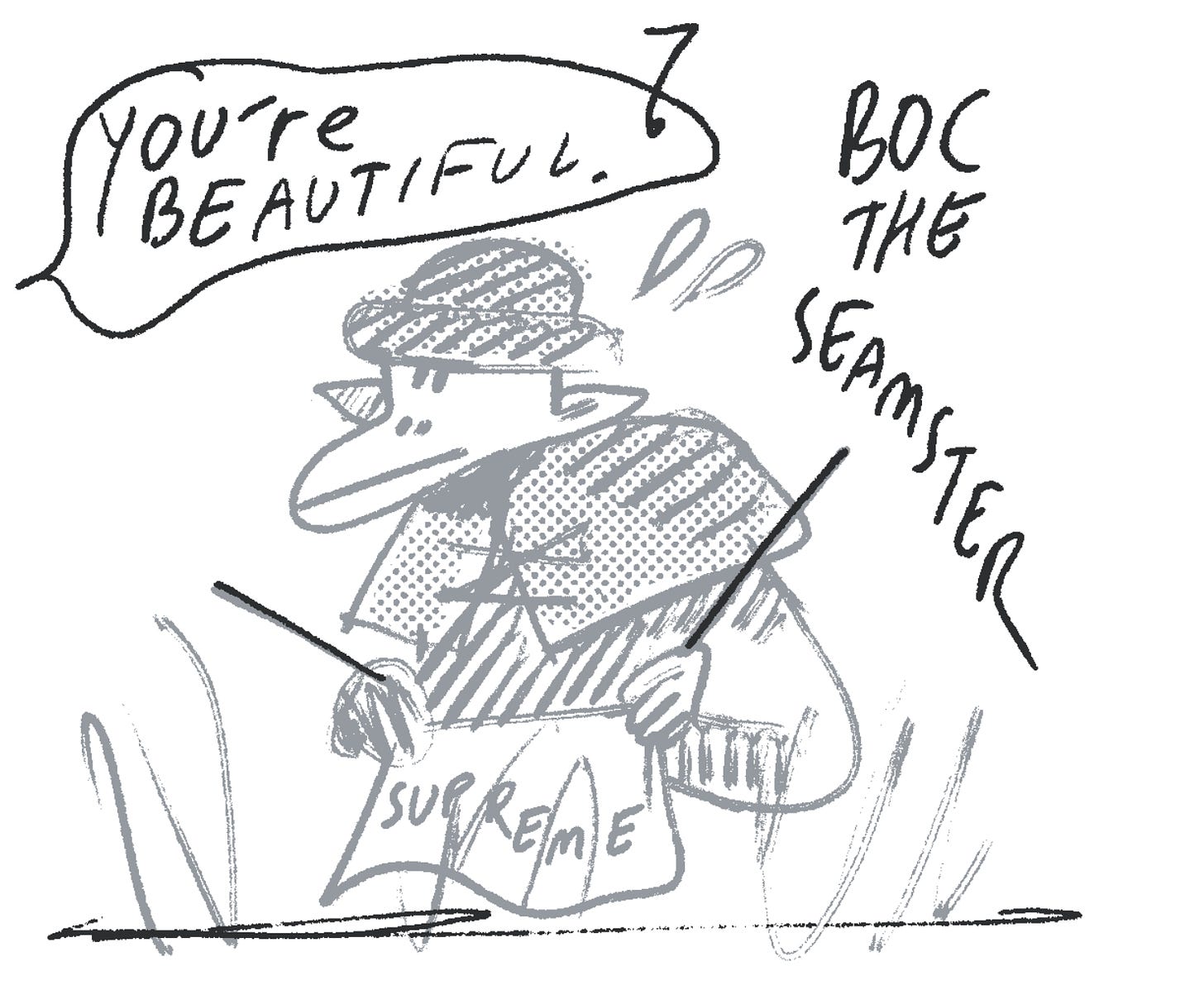
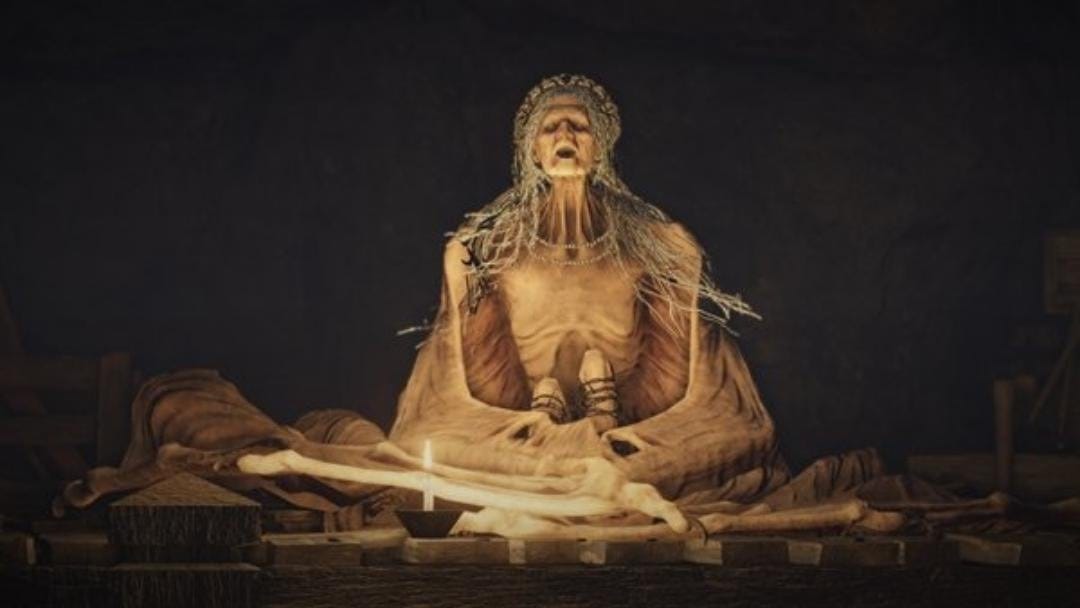

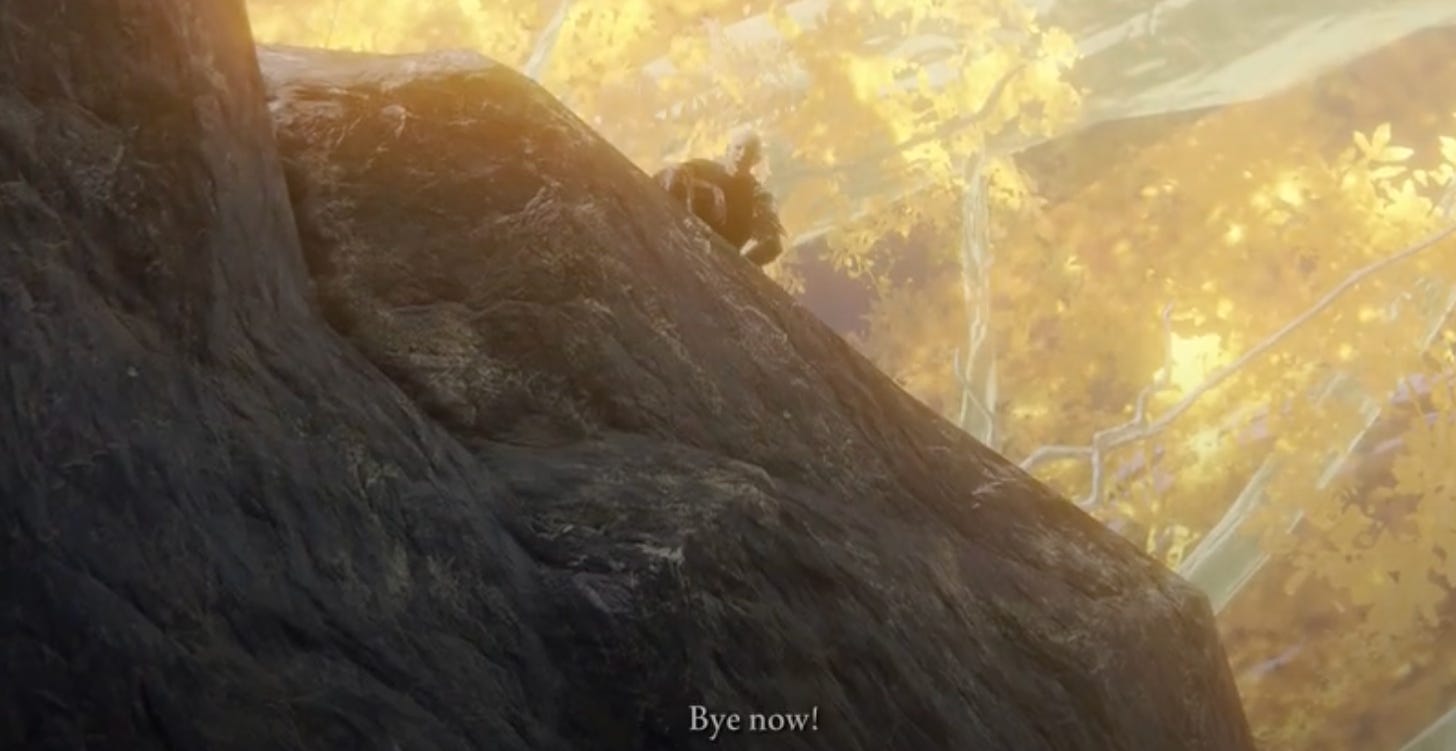
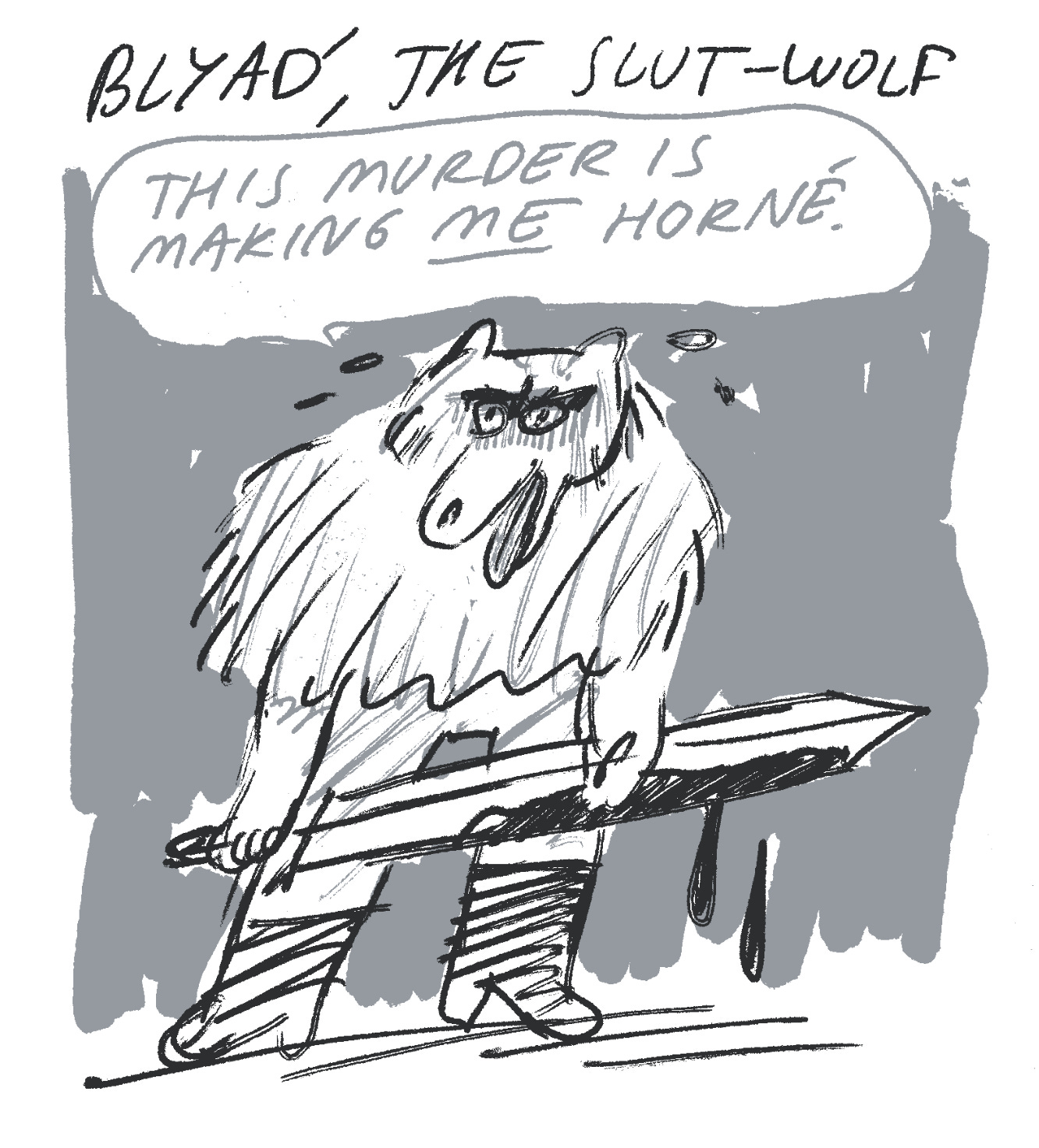
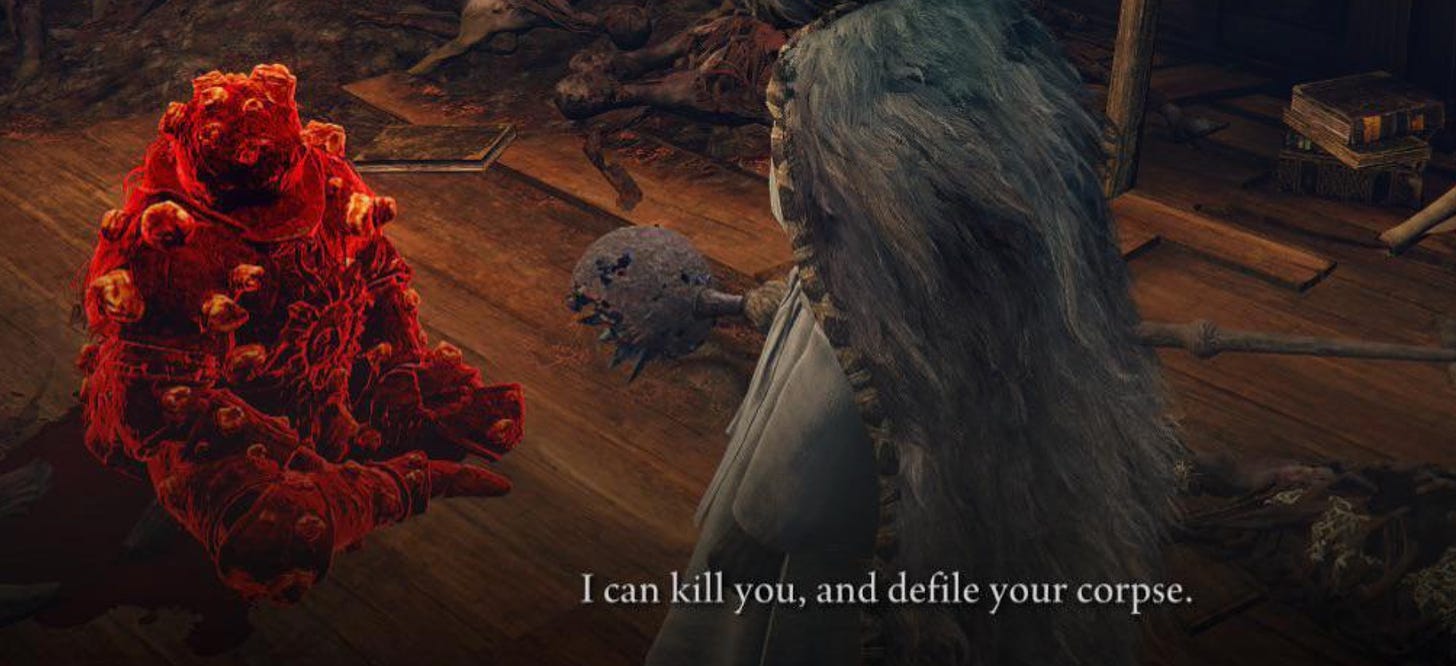
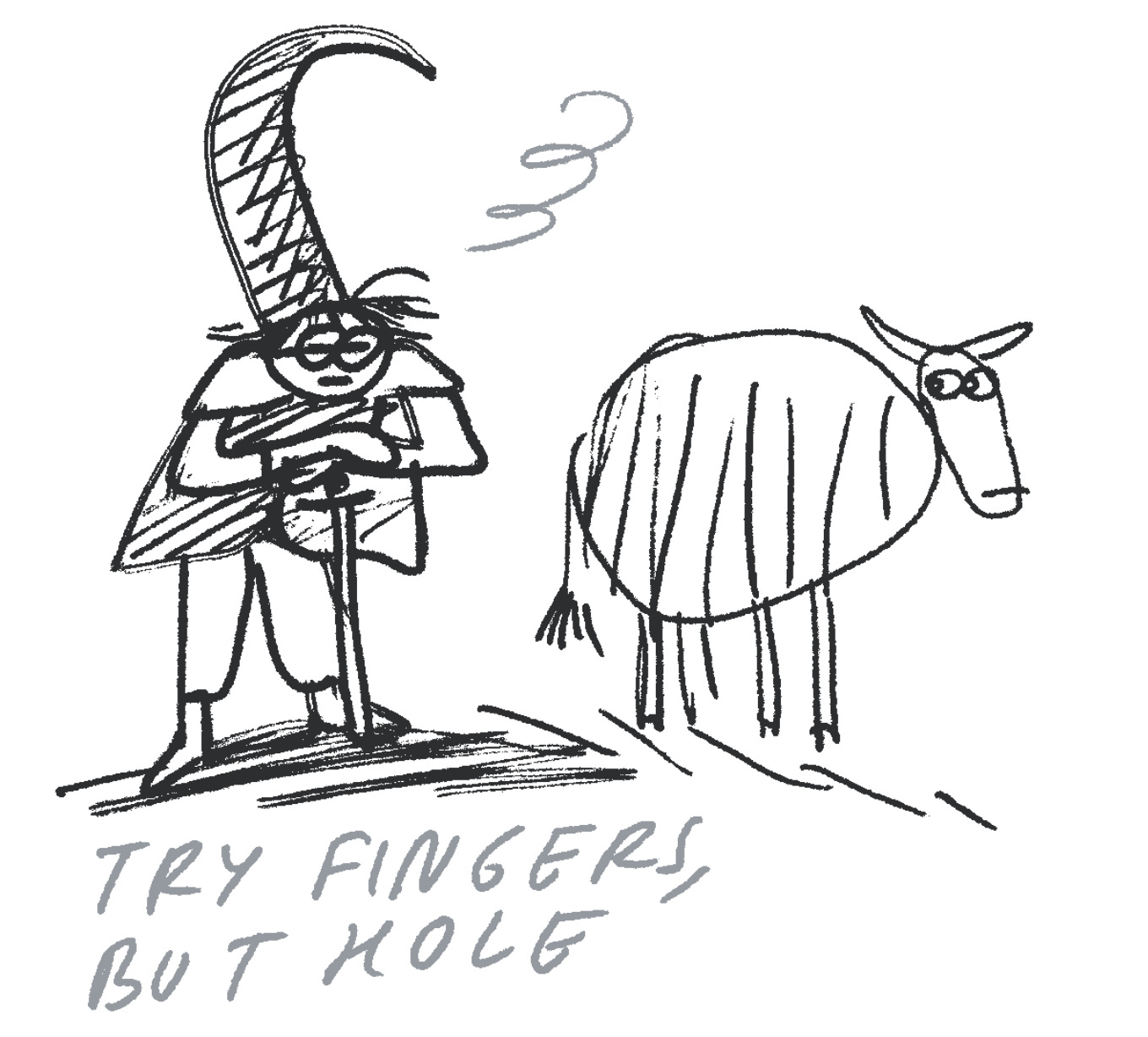
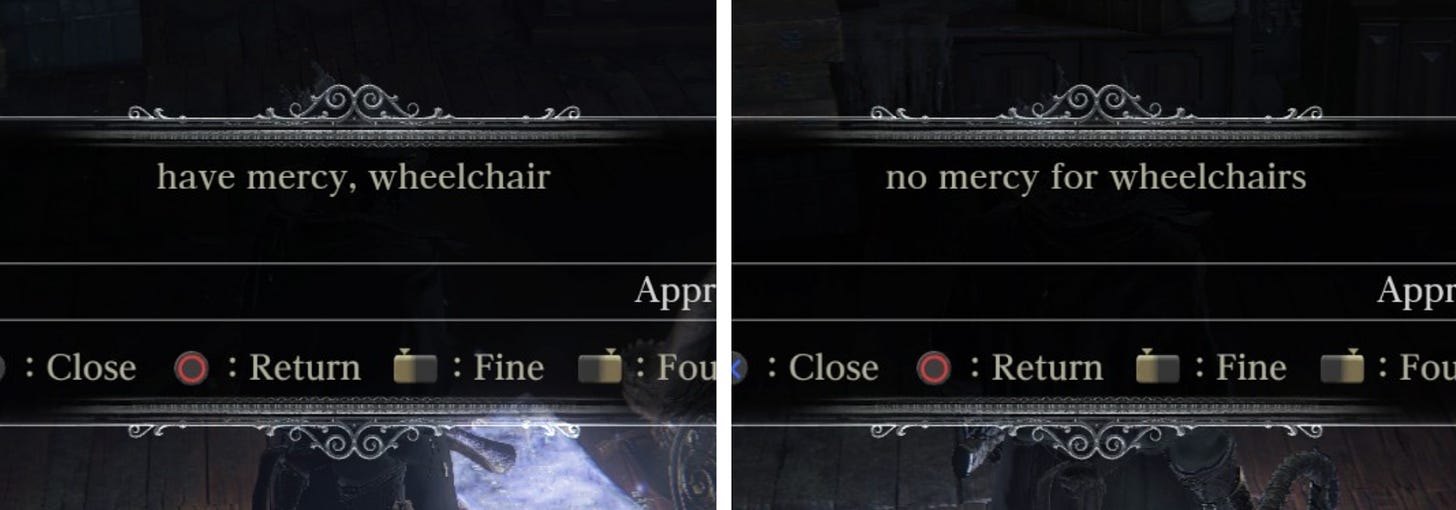
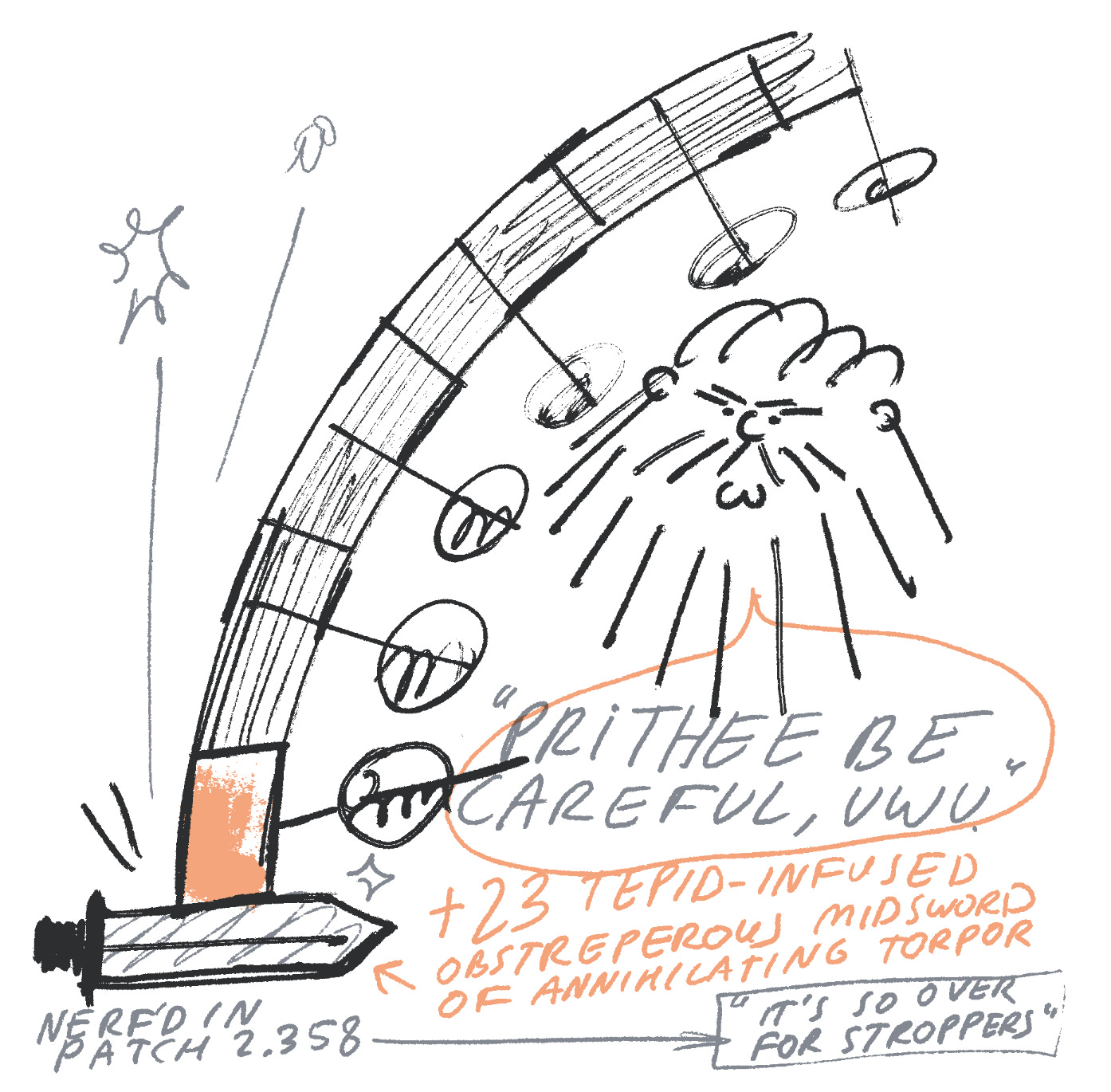

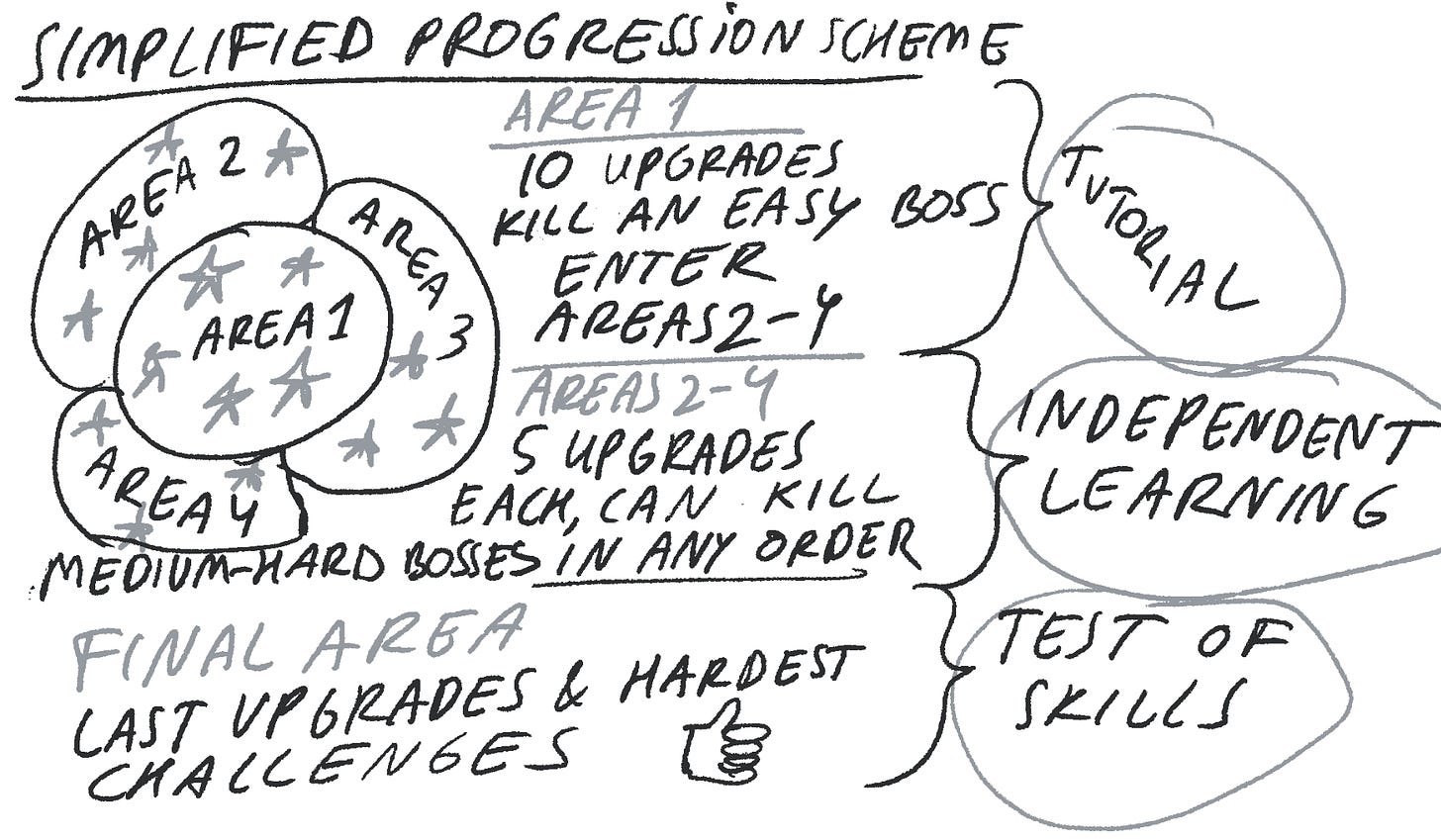
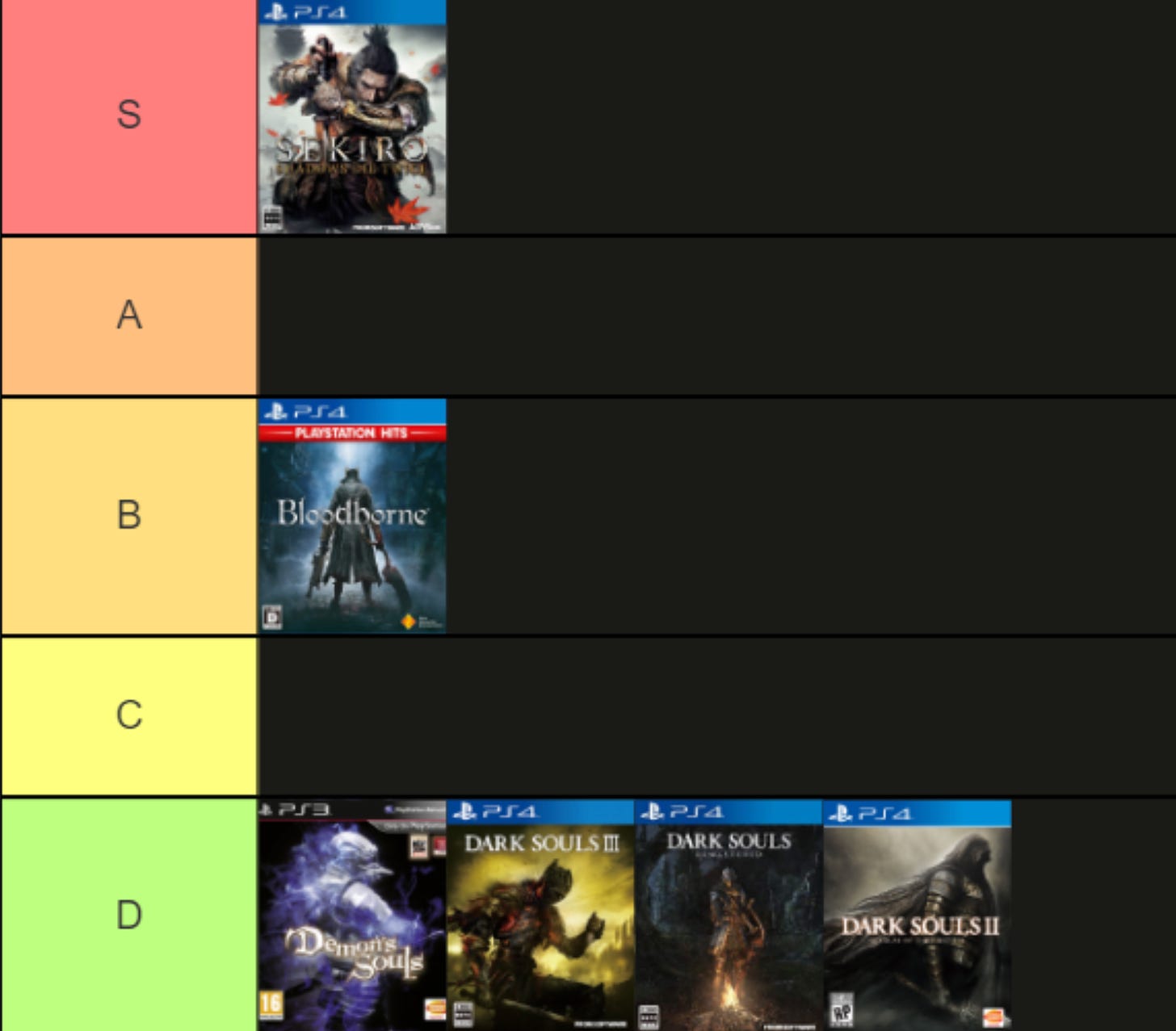
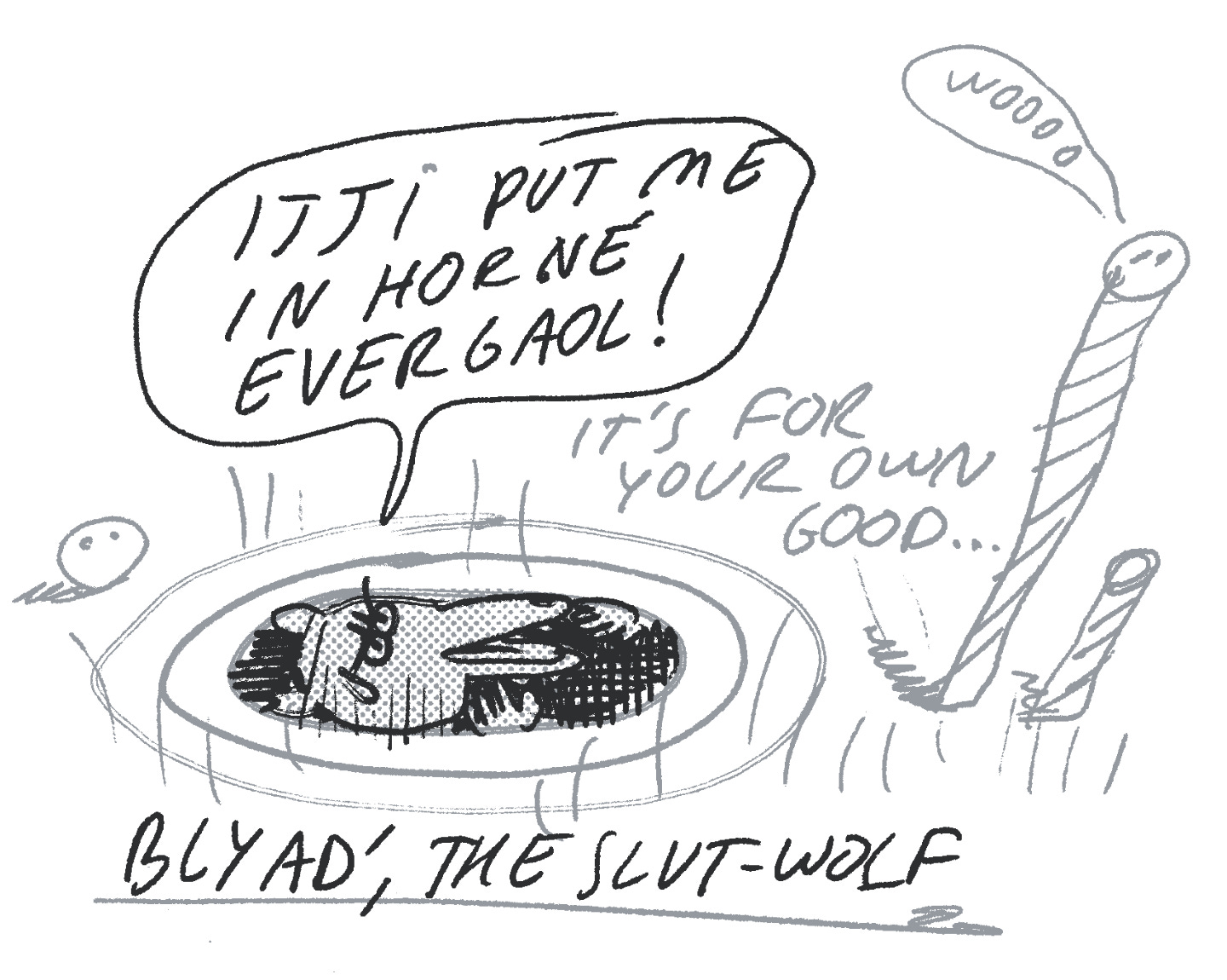


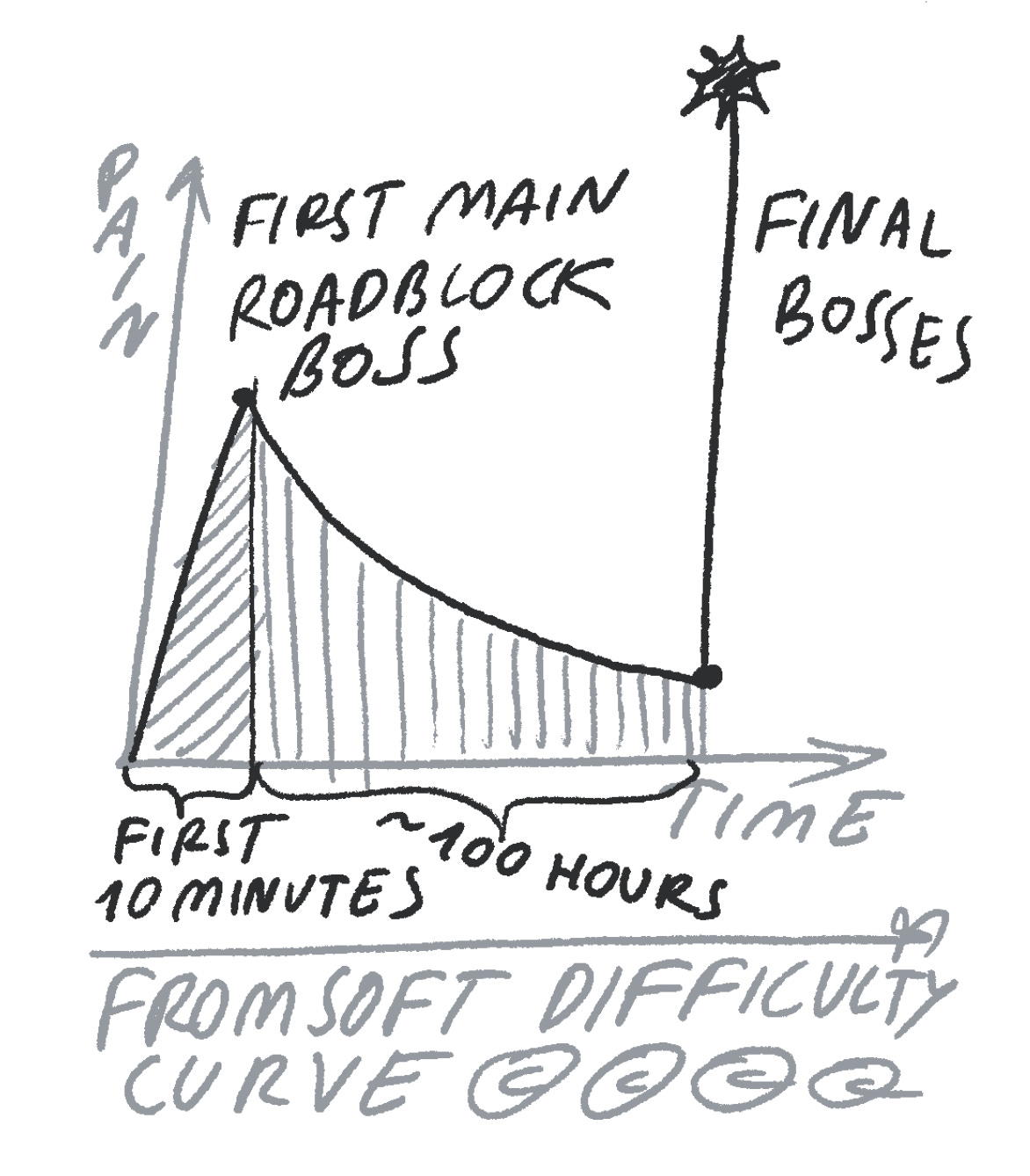


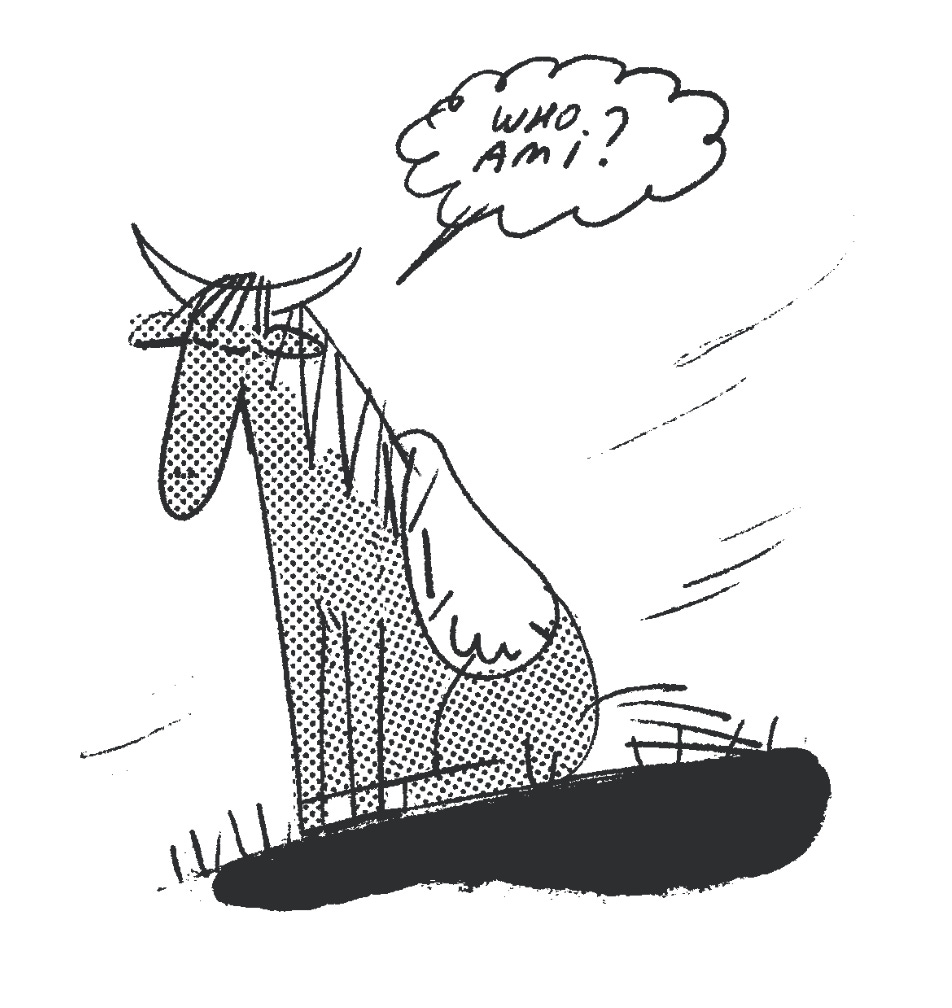
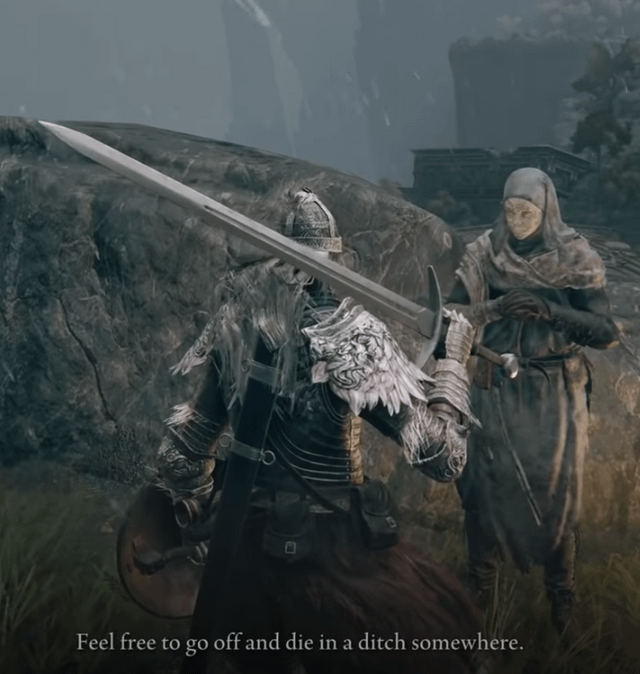

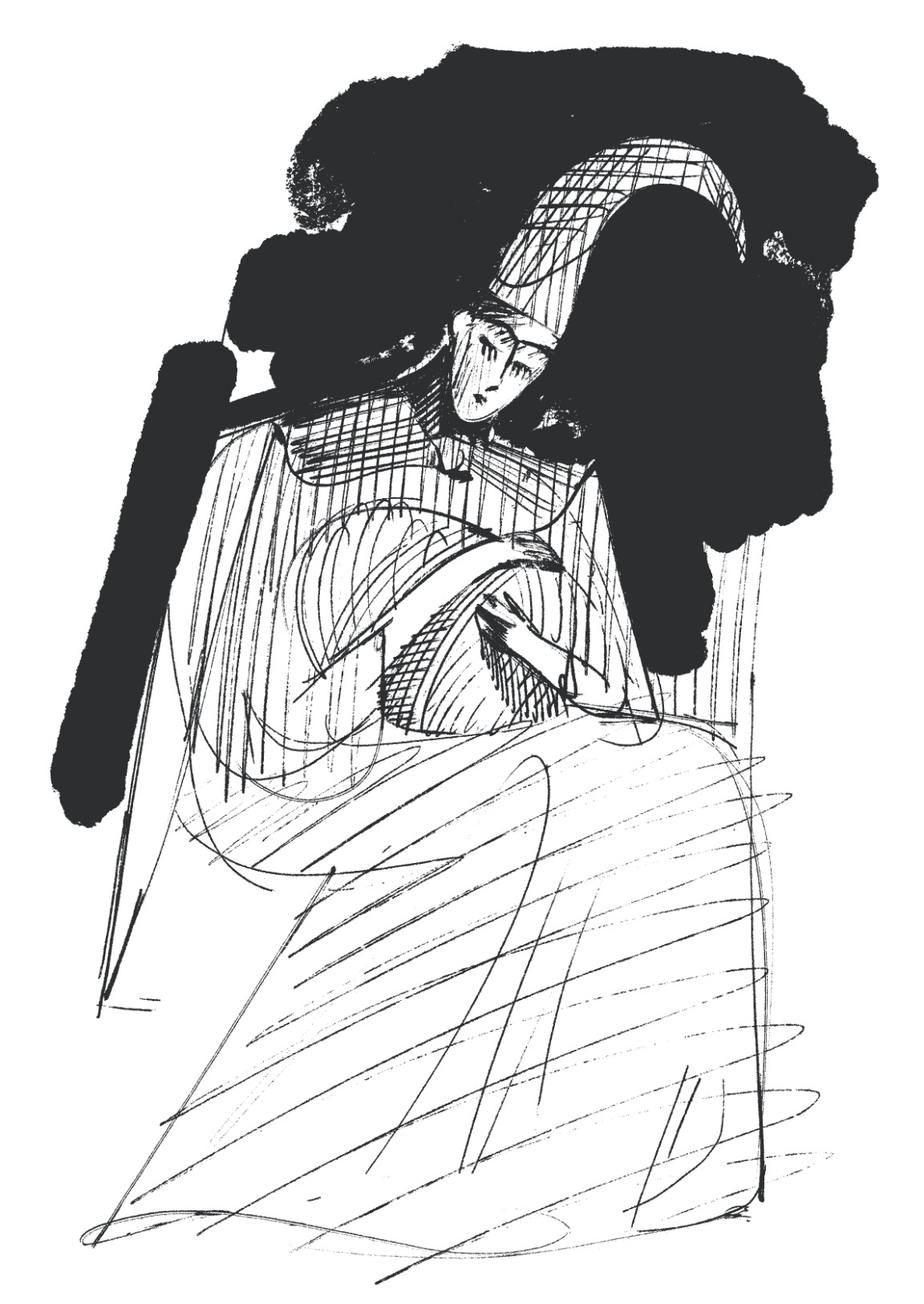

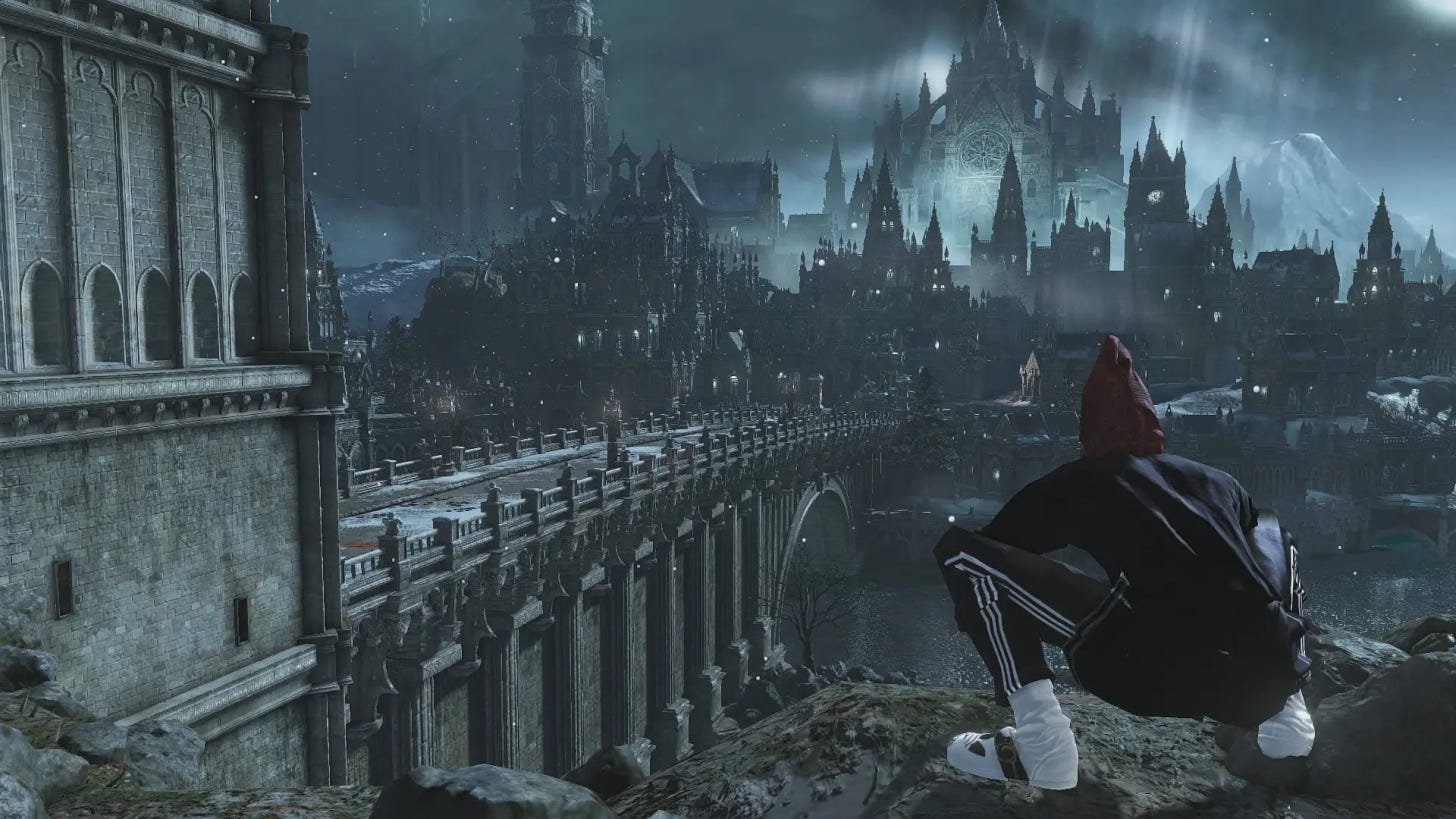

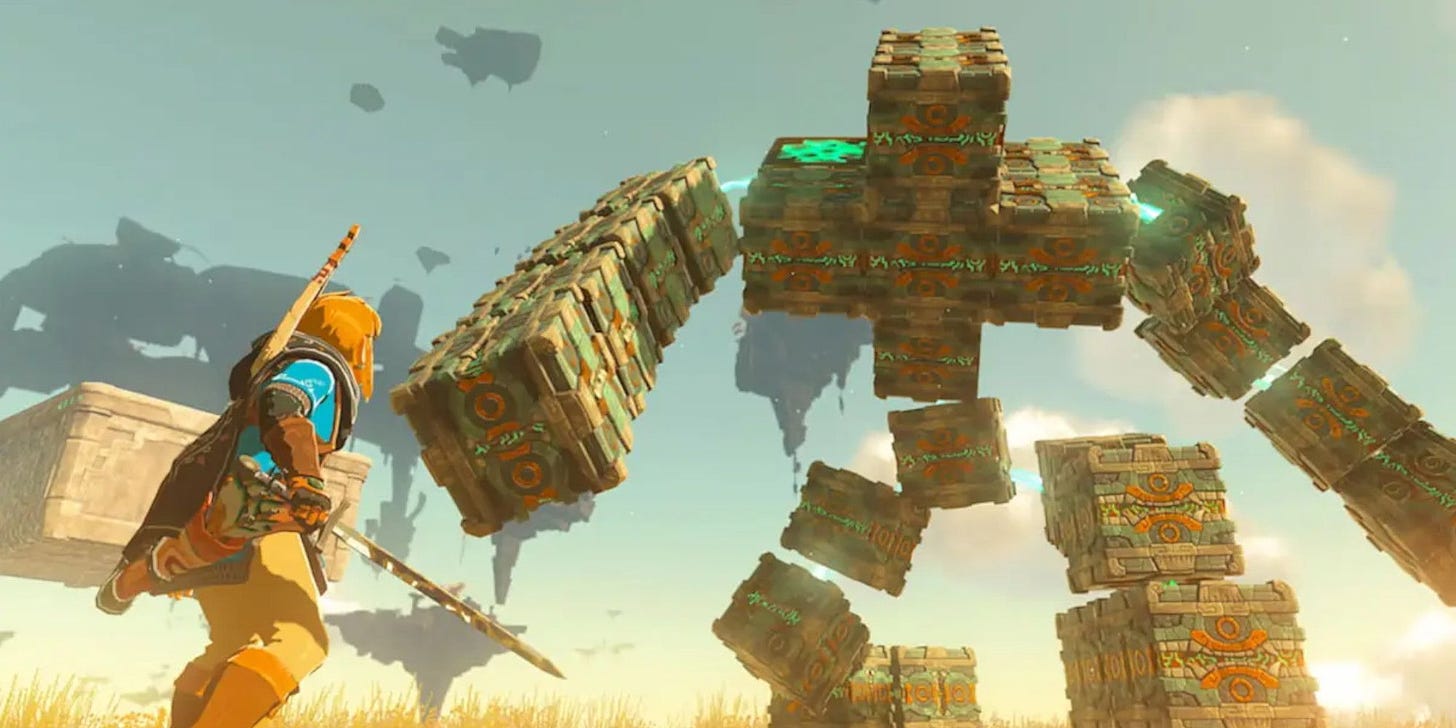
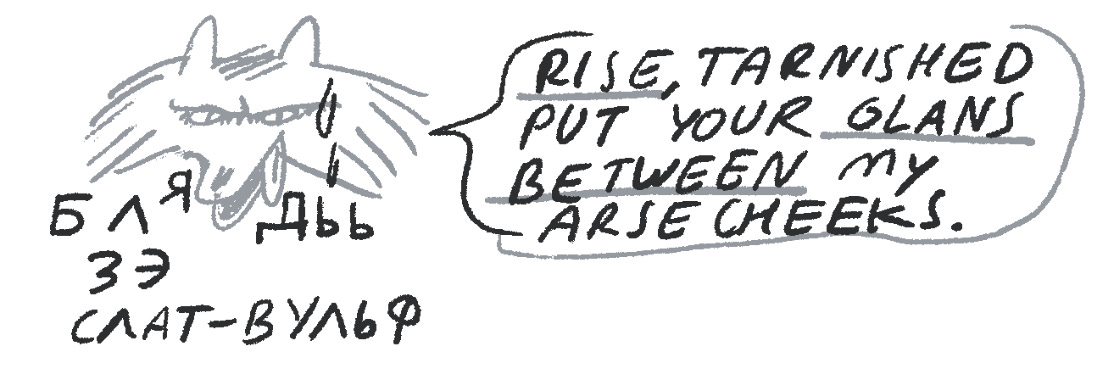

I enjoyed this post, and the depth of thought you bring to the game's design. I enjoyed this post way more than I've enjoyed any From Software game. I have played, and play, many games without ever getting 'gud', and I've always felt I'm barred from entry to Dark Souls etc by my stubborn inability. Elden Ring has tempted me because of the opportunities for exploration it appears to offer., and your post make me more tempted. So maybe I'll get it in the Steam sale or whatever. And then I can blame you. Cheers!